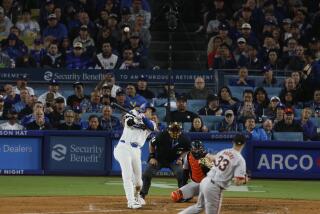Easton Bats Are Big Hits
- Share via
On a Los Alamitos ball field on a recent Tuesday, fifth-grade pitcher Nathan Berger of the Mariners reached back and fired a fastball for a strike to batter AJ Crook of the Yankees.
But armed with an Easton Triple7 alloy bat, AJ won the battle between the St. Hedwig Pony League players by smacking a hard ground ball to the shortstop, scoring the runner on third.
AJ and thousands of other youth baseball and softball players are using similar bats to make a winner out of Easton Sports Inc. of Van Nuys, which makes about one of every two baseball bats sold in America.
AJ’s Triple 7 bat isn’t anything like the $12 wooden bat his father used a generation earlier. It’s lighter, weighing barely 20 ounces, and has a wider barrel, creating a bigger hitting surface. AJ can whip the 29-inch bat at a faster speed and hit the ball harder than he would with a wooden bat, or even an earlier aluminum model.
But here’s the number Easton really likes. The Triple 7 lists for $150 at batting cages and specialty retailers such as Sport Chalet Inc. stores and represents one of the few bright spots for a baseball equipment business that’s suffering from a dearth of players.
Easton has built on the metallurgy skills first developed by a sister company that makes aluminum archery arrows to become the nation’s leading maker of high-profit, premium bats.
The privately held company, along with the No. 2 player in the bat business, Hillerich & Bradsby Co., owner of the Louisville Slugger brand, is responsible for much of the growth in the baseball equipment business in recent years.
Wholesale shipments by U.S. manufacturers of baseball and softball equipment grew 26% to $440 million from 1995 to 2000, the latest year reported by the Sporting Goods Manufacturers Assn. Bat sales accounted for the majority of that gain. By 2000, the bat business accounted for 37% of all baseball equipment sales, up from 25% five years earlier.
During this period, the cost of a premium bat doubled and in some cases tripled to $150 to $250--the price of the bats AJ and his teammates use. His mother, Janet Crook, said she cringed before paying $150 for a bat for a youngster. But she noticed AJ’s hitting improved after he borrowed a similar bat from a friend last summer.
Now, she said, it’s not unusual to see $1,000 worth of bats dangling from the dugout racks on the St. Hedwig Catholic School ball field where the Yankees, Mariners and other youth teams from the area play.
Although bat sales have increased, the number of players has declined at both the youth level and at recreational adult softball leagues.
The 435 players taking the field twice a week at St. Hedwig are the diamond die-hards of youth sports, those who have not forsaken the national sport for that import--soccer--or a whole range of more sedentary activities.
“Sporting goods manufacturers and retailers are all faced with the same challenge,” said Craig Levra, chief executive of 24-store Sport Chalet. “We have to do a better job getting kids fired up to play. Our biggest competitor is not another sporting goods manufacturer or retailer; it’s video games and television.”
According to an annual study by the Sporting Goods Manufacturing Assn., the number of Americans age 6 or older playing baseball has declined 25% since 1987. In the last five years, the Little League organization has lost 8% of its baseball and softball players.
“With the exception of soccer, just about every team sport is seeing a decline in participation,” said Anthony Palma, Easton’s chief executive.
Although he blames video games and television for much of the drop, Palma also noted that the decline in sports participation parallels a dip in the number of hours students spend in physical education classes at school.
Faced with a smaller player pool, Easton has focused on developing new products that allow it to increase profit margins and gain market share, Palma said.
The Sporting Goods Manufacturing Assn. is looking at programs that would reverse the slide in sports participation, but most equipment makers are not expecting big gains. They are worried about continued declines, especially if there is a strike or work stoppage by the Major League Players Assn. this year.
Given the static market, any gain by one manufacturer comes at the expense of another.
“The only way to gain market share is either to have the lowest price or the most innovations,” Palma said.
Easton has chosen the second path, developing bats that allow players to hit the ball farther and harder. Some have carbon fiber linings that reinforce the outer walls, helping the bat pop back when it strikes the ball. Others have a textured surface that helps put backspin on the ball. Easton’s Tri-Shell bat for adult softball has a rubber lining sandwiched between aluminum alloy walls for more bounce.
“We have found that consumers are willing to pay more for products that improve their performance,” Palma said.
The company controls 45% of the aluminum bat market, and Palma believes there’s room to grow Easton’s share to 60% or higher.
Wood bats are used primarily by professional players and make up only a small portion of bat sales, and Easton has a small wood bat factory at its Van Nuys plant, where it makes custom bats for Anaheim Angels star Darin Erstad, Rafael Palmeiro of the Texas Rangers and other major league players. (Professional players use only wooden bats.)
Easton, whose sales reached $160 million last year and have grown by an average of 9% annually over the last five years, now accounts for about one of every five dollars spent on baseball equipment at the wholesale level. It also makes hockey sticks and other equipment, as well as bicycle frame tubing and parts. Baseball accounts for slightly more than half of Easton’s revenue.
Rawlings Sporting Goods Co. of Fenton, Mo., famous for its baseball gloves and baseballs, is the largest publicly traded baseball and softball supplier. The company, which posted $174.5 million in revenue last year from baseball and other sports, has suffered from flat sales and marginal profit for several years.
Easton, which has 1,200 employees, including 45 engineers working on product development, declined to provide specific earnings figures. But people in the industry outside of the company confirmed Palma’s assertion that Easton’s profit margins are among the highest in the sporting goods business.
As Easton’s bats add more exotic metals and alloys, players said they are hitting the ball farther. But they also are encountering problems with some equipment.
AJ’s Triple 7 bat is his second. Janet Crook returned the first one after only a month when it became dented from a pitched ball. Easton sent the family a new bat, but this one also has developed a dent even though AJ has followed the warranty rules and has not used it to hit off a pitching machine.
Several Mariners and Yankees at the recent game also reported dents in expensive, high-tech bats made by Easton and similar models produced by Hillerich & Bradsby under the Louisville and TPX brand names.
Palma said he is not aware of “any unusual problems,” adding that the company has about a 3% return rate and puts its products through rigorous testing.
At the bat factory in Van Nuys, for example, Easton uses an air cannon to shoot baseballs at 140 mph to test bats four feet away. The company bathes bats in saltwater to judge their rate of corrosion and runs durability tests on the handles.
One room of the factory houses a batting cage. Along the wall, racks hold brightly anodized yellow, orange, blue and green bats--at least one model of every bat style Easton manufactures. Inside the cage, two former minor league ball players who are part of Easton’s research-and-development team operate a pitching machine and take turns hitting baseballs to test production bats and prototypes. It’s not unusual for them to each hit 250 balls in a typical workday.
Easton is building on its success in bats to expand to other baseball products. Levra, head of the Sport Chalet chain, said Easton has become a major player in baseball shoes and gloves.
Palma said the company is studying how to use some of the improvements in lightweight hockey protective equipment to develop a line of catcher’s gear.
“We are now the No. 3 company in baseball cleats after Nike and Adidas,” Palma said. “We are doing well in gloves and mitts. What we have done is taken a bat company and turned it into a full-line baseball company.”
More to Read
Inside the business of entertainment
The Wide Shot brings you news, analysis and insights on everything from streaming wars to production — and what it all means for the future.
You may occasionally receive promotional content from the Los Angeles Times.











